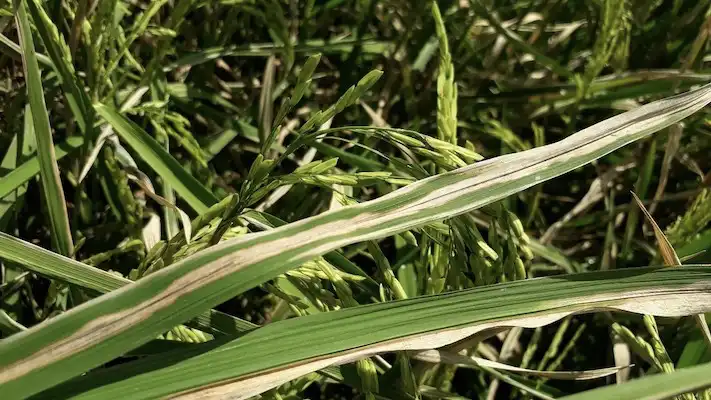The “Healthy Crops” international research consortium led by Professor Dr Wolf B. Frommer from Heinrich Heine University Düsseldorf (HHU) is developing disease-resistant rice varieties. In the scientific journal eLife, the authors now report on the discovery of a recent bacterial outbreak in Tanzania – and describe how they modified an African rice variety to make it resistant to the pathogen.
Bacterial blight of rice, which is caused by the bacterium Xanthomonas oryzae pathovar oryzae (Xoo for short), is responsible for devastating crop losses among rice farmers every year. It above all threatens the livelihoods of small-scale farmers in Asia and Africa, and accounts for malnutrition and famine in the affected regions.
Although bacterial blight was not considered a major threat to rice production in Tanzania until now, in 2019 fields were detected in the Morogoro region in east Tanzania that showed in part severe damage by the disease. Subsequent surveys further indicated that the pathogen had already spread to many regions of Tanzania by now. Based on the rapid spread, it is not unlikely that the disease will also migrate to neighbouring countries. To determine the arsenal used by this strain, the pathogen’s genome was sequenced. The analysis of the sequences showed that the bacteria are distinct from the native populations in Africa and are highly similar to strains from Asia. Similar to the Asian strains, but different from the African ones, they have one tool that blocks a common rice resistance gene, called iTAL, and they possess a particular set of keys to the plants’ pantry. Injection of a regulatory “key” protein, developed by these bacteria, into rice cells turns on the production of a sugar transporter named SWEET11a that leads to the release of sugar in the neighbourhood of the bacteria, which can serve for nutrition and is needed for multiplication and virulence of the bacteria.
According to Dr Boris Szurek, who heads the group involved in the study at the French national research institute for sustainable development (IRD): “Until 2019, strains from Asia were never found in Africa. Similarly, African strains were not found in Asia, pointing to a recent introduction from Asia into Africa, which is now causing yield losses across Tanzania.”
Professor Dr Wolf B. Frommer from the Institute of Molecular Physiology at HHU, who heads the international research consortium “Healthy Crops“, explains: “To protect African rice production from the emerging threat by the pathogenic bacteria, we have used new breeding techniques to exchange the locks in the popular East African elite variety “Komboka” so that the pathogen’s key cannot open the pantry anymore and thus, not cause the disease. The edited lines show broad-spectrum resistance against all known Asian and African strains of Xoo, including the strains recently discovered in Tanzania.”
Co-author Professor Dr Bing Yang from the University of Missouri in Columbia, USA adds: “We intend to help African scientists with these discoveries and use new breeding methods to develop locally adapted disease-resistant rice varieties. The knowledge can also be used to inform conventional breeding of varieties resistant to the rapidly spreading strains for those countries that have not yet established regulations for new breeding techniques.”
Background: bacterial blight of rice
Rice production is vital for food security, regional development and poverty alleviation in many countries, especially developing ones. Around 900 million people from low-income households worldwide currently rely on rice production as producers or consumers. Rice is the most important staple food for more than four billion people worldwide.
Bacterial blight is a devastating rice disease that threatens the livelihoods of small-scale, low-income food producers in Africa and Asia in particular. In India for example, almost ten percent of harvests are lost to this disease every year – and that despite effective protective measures. The new rice lines developed could prevent these yield losses and thus provide rice for many millions of people, who would be at risk of famine otherwise.
The disease is caused by the bacterium Xanthomonas oryzae pathovar oryzae (Xoo for short). During infection, Xoo introduces a series of proteins called TAL effectors into the plant cells, which bind to the host genome and activate the expression of plant genes, thereby promoting the production of sucrose transporters from the “SWEET” family. Once the SWEETs are integrated into the plasma membrane, the cells secrete a large amount of sugar which the Xoo bacteria then feed on. This in turn leads to wilting and desiccation of the leaves and eventually to the death of the rice plants.
“Healthy Crops” project
Pesticides are often used to combat Xoo, however their effectiveness is limited and they expose the population to risks. The “Healthy Crops” non-profit international research project is taking a different approach, with the aim of breeding and making rice lines available that are resistant to the disease. This is expected to significantly increase yields for small-scale food producers in Africa and Asia.
The project is an international consortium involving scientists from HHU, the University of Florida and University of Missouri in the USA, the International Centre for Tropical Agriculture in Colombia (CIAT), the French national research institute for sustainable development (IRD), the International Rice Research Institute (IRRI) in the Philippines and Kenya, and two institutes of the Indian Council of Agricultural Research (ICAR). The project is led by Professor Wolf B. Frommer, who is based at HHU; Dr Marcel Buchholzer is responsible for coordination of the project in Düsseldorf.
To achieve its goals, the consortium has developed a strategy to combat bacterial blight. The team has already successfully bred disease-resistant rice lines. A diagnostics toolbox has additionally been developed to enable the rapid diagnosis of emerging pathogenic bacterial strains.
HHU is supported in the Healthy Crops project by the Bill & Melinda Gates Foundation grant ID INV-008733.
Read the paper: eLife
Article source: Heinrich Heine University Düsseldorf (HHU)
Author: Arne Claussen
Image: Close-up of a rice leaf infected by Xoo. The bacterium migrates through the leaf and causes the typical lesions. Credit: Mohammed Mkuya, Rosemary Murori








